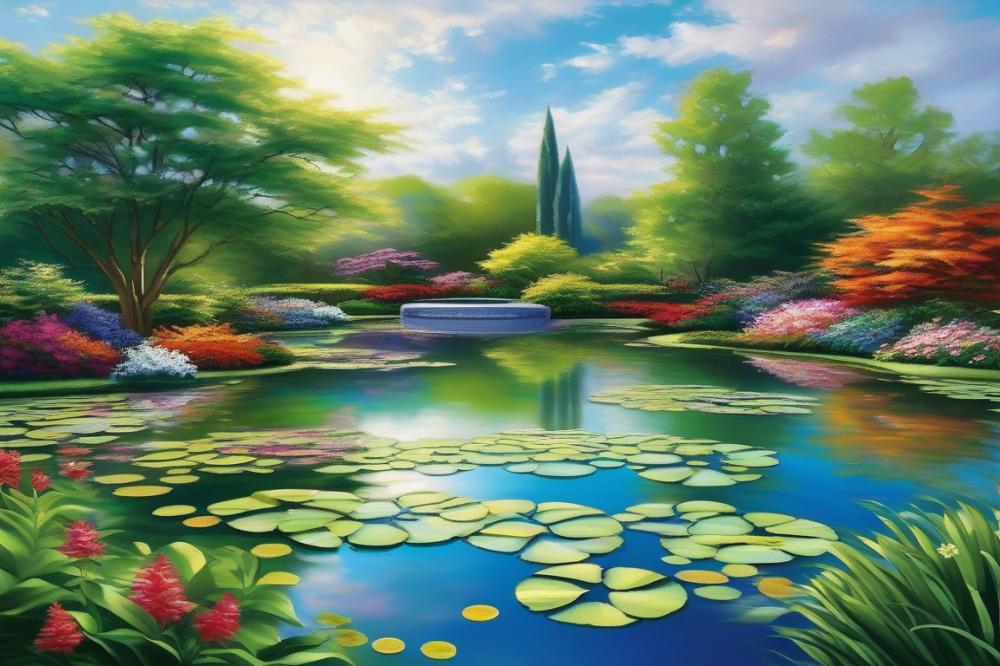Incorporating Tropical Elements in an Exotic Garden
Have you ever imagined stepping into a lush retreat filled with vibrant colors and exotic plants? tropical gardens seem to invite you into a world away from daily routines. They create a stunning atmosphere that can brighten the dullest of spaces. Envision palm trees swaying gently in the breeze while radiant flowers paint the landscape. Such a setting offers a unique charm, making outdoor living more enjoyable.
Incorporating tropical elements into garden design isn’t just about appearance; it’s about evoking a certain feeling. By adding features that resemble these warm, lush environments, you transform your yard into a peaceful oasis. This doesn’t just capture attention; it draws people in. Many appreciate the serenity that a garden can provide, turning their outdoor space into a personal paradise.
Consider the benefits of biodiversity as well. A varied ecosystem encourages healthier plants and attracts fascinating wildlife. Incorporating humidity-loving plants can lead to a vibrant habitat right in your backyard. Exotic fruits might even provide delicious snacks during summer days. Plus, enhanced plant care practices will keep your garden thriving throughout the seasons.
Living outdoors starts with creating an environment you love. Every glance at your tropical-inspired garden can uplift spirits and offer a refuge from the busy world. Gardening becomes not just a hobby, but a lifestyle. Dive into the world of tropical decor and start designing your own exotic escape today!
Understanding tropical gardens
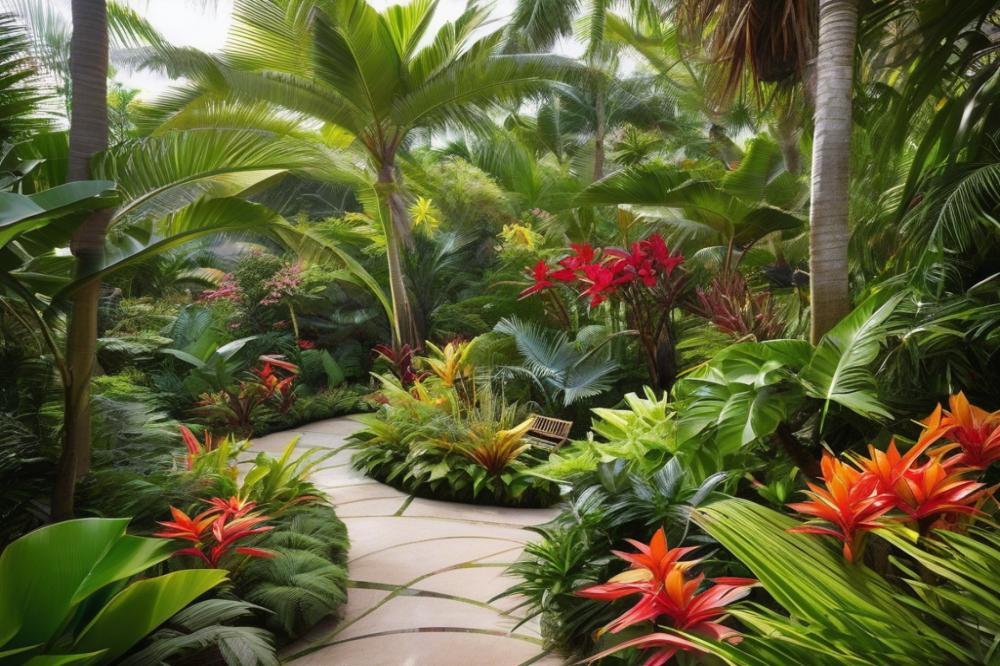

Tropical gardens are vibrant spaces that mimic the lush habitats found in tropical climates. These gardens often feature rich biodiversity, filled with a variety of plants and wildlife. They transport people to a paradise-like setting right in their backyards.
Characteristics of Tropical Landscapes
In these landscapes, landscaping plays a key role. Large palm trees provide height and an iconic skyline. The ground bursts with colorful, vibrant flowers that seem to dance in the breeze. Exotic fruits growing on trees add both beauty and flavorful snacks. It’s all about creating a paradise that looks wild yet welcoming. Shadows from towering greenery create cool spots, perfect for outdoor living and relaxation. Each plant, whether tropical decor or decorative foliage, contributes to a stunning visual experience.
The Role of Humidity in Tropical Garden Success
Humidity is critical for maintaining a thriving tropical environment. Many plants thrive with a high moisture level in the air, which mimics their natural habitat. This moisture supports healthier growth, boosting their vibrancy. When planning garden design, consider areas that naturally hold humidity. A small pond can help. Proper plant care is essential too. Many plants require consistent watering during dry spells to maintain their exotic appeal. Understanding the balance between moisture and sunshine is vital.
Incorporating these elements into your garden can create a unique ecosystem. It invites wildlife and enhances the experience for anyone who visits. However, the successful integration of these components often shapes the overall success of your garden.
Choosing the Right Plants
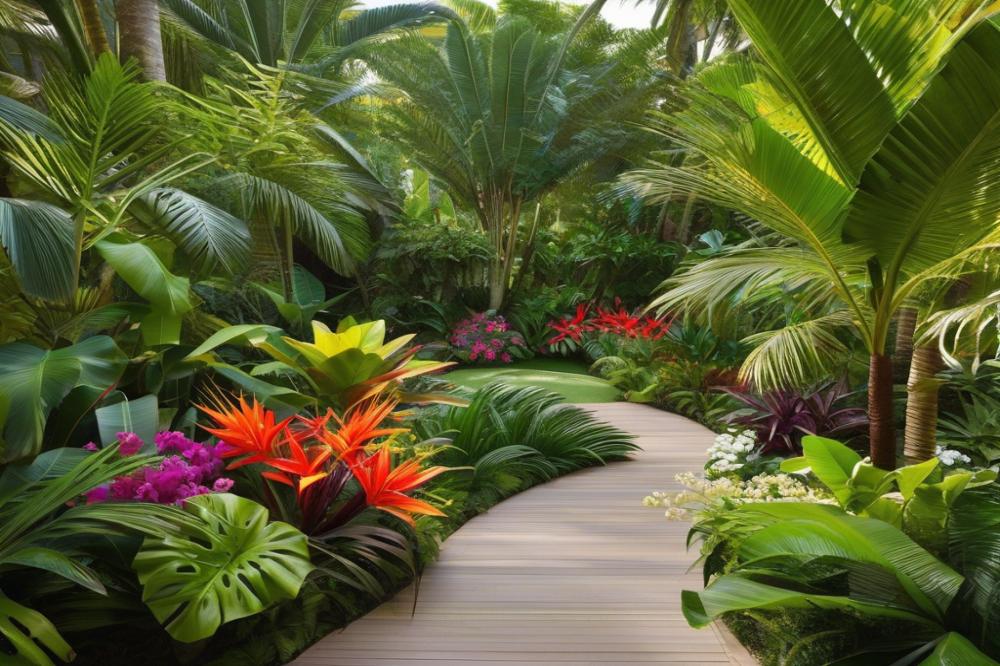

Choosing suitable palm trees is a fundamental step in your garden design. Start by understanding your local climate. Some species thrive in hot and humid conditions, while others prefer cooler temperatures. For instance, the Queen Palm can handle a range of environments but is best in warmer zones. Look for options that can grow tall to create visual interest and provide shade in outdoor living areas.
Incorporating vibrant flowers is another way to add flair to your garden. Bright colors can evoke the feeling of a paradise. Consider plants like hibiscus, bougainvillea, or bird of paradise. These flowers not only bring color but also attract pollinators like bees and butterflies. Mixing varieties creates a visually appealing display. Select flowers that bloom at different times to maintain beauty throughout the seasons.
Growing exotic fruits can enhance your garden’s appeal and offer fresh produce. Fruit trees such as mango, papaya, and passionfruit add both aesthetics and flavor. Each requires specific care to thrive. Ensure you provide enough sunlight, adequate humidity, and proper feeding. Understanding these needs will help you cultivate a productive and eye-catching space.
Plant compatibility is essential for a successful exotic garden. Position plants that share similar water and sunlight requirements nearby. This approach promotes healthy growth and a balanced ecosystem. Incorporating a mix of plants also enhances biodiversity. Diversity in your garden supports local wildlife and creates a robust environment. Emphasize the importance of researching each plant’s needs to form a thriving outdoor oasis.
Design Techniques for an Exotic Look
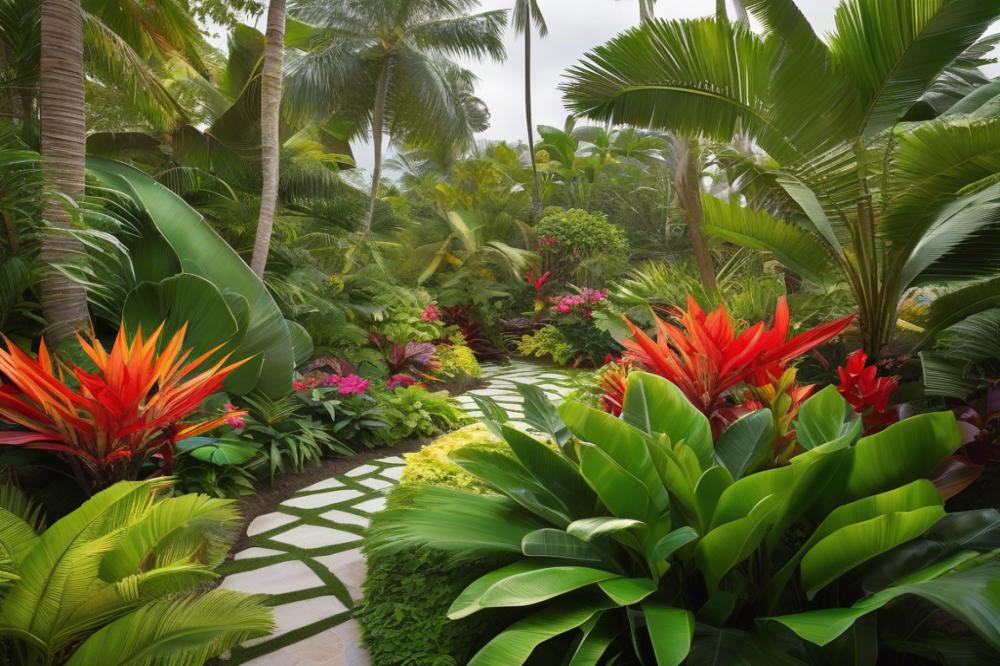

Creating a garden that captures the tropical vibe involves key principles of garden design. Emphasizing vibrant flowers and palm trees instantly sets the mood. Texture and color play significant roles. Use a mix of leafy greens and colorful blooms to achieve a lively space. Consider the height of plants; taller ones can create a backdrop for shorter varieties, adding depth.
Layers are crucial for an eye-catching look. A well-thought-out arrangement draws visitors in. Place larger plants at the back and smaller ones in the foreground. This strategy creates a natural hierarchy. Incorporate various species, including those that bear exotic fruits, to enhance biodiversity within your garden.
Tropical decor can elevate your space with charm. Statues and fountains infuse a sense of tranquility. These features can reflect the beauty of nature while adding distinct character. Consider colorful ceramics or natural materials that harmonize with plant life. Selecting decor that complements your theme will enhance the overall experience.
Pathways guide visitors through your oasis, inviting exploration. Use stones, gravel, or wood to create a journey. Pathways also serve as a base for outdoor living spaces. Add seating areas that allow relaxation among plants. Benches or hammocks provide spots for enjoyment and contemplation.
Incorporating tropical elements isn’t just about plants. Think about how humidity affects your garden’s design. Some plants thrive in moist conditions, while others may need extra care. Researching plant care will make a significant difference. Choosing the right varieties ensures they flourish in their new home.
landscaping Practices for a Sustainable Tropical Garden
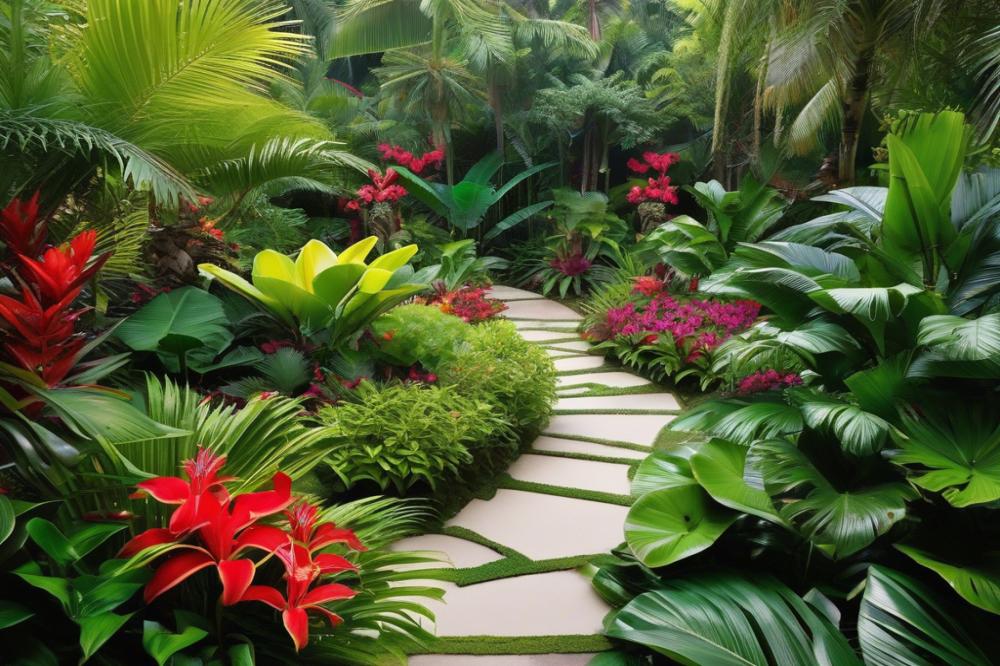

Soil Preparation and Drainage for Humidity-Sensitive Plants
Creating a perfect environment starts with the right soil. Tropical plants thrive in well-draining soil. Mixing organic matter can enhance soil quality significantly. Consider adding sand or perlite to improve drainage. Avoid heavy clay that retains too much water. Palm trees and vibrant flowers prefer moisture, but roots shouldn’t sit in water. Test your soil’s pH too; tropical plants often favor slightly acidic to neutral conditions.
Watering Techniques for Tropical Landscapes
Watering is crucial in a tropical garden. Morning is the best time to water since it reduces evaporation. Use drip irrigation to target roots directly. This method saves water and keeps foliage dry, which can prevent disease. Rainwater harvesting is another fantastic strategy. It’s eco-friendly and free! Remember, over-watering can harm many tropical plants. Adjust watering based on weather; hot, sunny days require more moisture.
Mulching and Organic Practices to Maintain Soil Health
Adding mulch helps retain soil moisture. This layer also suppresses weeds that compete with your beloved plants. Organic mulch such as wood chips or straw is beneficial. It breaks down and enriches the soil over time. Combine this with composting to create nutrient-rich bedding for your garden. Exotic fruits will flourish in a healthy environment. Healthy soil leads to vibrant flowers and an overall thriving landscape.
Pest Management Strategies for Tropical Plants
Dealing with pests can be challenging, but it’s essential. Start by inspecting plants regularly for signs of trouble. Natural predators like ladybugs can control unwanted pests. Consider using neem oil or insecticidal soap for gentle treatment. Cultural practices, such as crop rotation, assist in breaking pest cycles. Increasing biodiversity by planting a variety of species can also help. This diversity creates a more resilient outdoor living space. Be proactive today to protect your tropical paradise!
Incorporating Tropical Elements Year-Round
Creating a lush landscape with tropical elements requires thoughtfulness, especially through the seasons. One thing to consider is the climate where you live. If you experience cold winters, plan your garden design so that it looks good even when the temperatures drop. Choose hardy plants like palms that can withstand cooler temperatures. Layering with diverse plant life can also help maintain visual interest. Think about including vibrant flowers that bloom at different times of the year to keep your garden looking lively and colorful.
Indoor tropical plant options can play a significant role in extending your tropical theme. Brighten up your indoor spaces with plants like monstera, peace lilies, or snake plants. These varieties not only bring beauty indoors but also help purify the air. Their leafy shapes and textures mimic an exotic feel, complimenting the outdoor setup. You can also use decorative pots that reflect tropical decor, helping to create a seamless connection between your indoor and outdoor spaces.
Creating Microclimates to Support Tropical Growth
Microclimates are a fantastic way to support the growth of tropical plants. Identify areas in your yard that naturally offer more warmth and humidity, such as spots near your home or beside hedges. Use these warm zones to plant more sensitive varieties like exotic fruits. Introducing features like trellises or shade structures can aid in creating additional sheltered environments. This will help your plants flourish, even in less-than-ideal conditions.
During hot summer months, consider adding water features to enhance the humidity around your tropical plants. A small pond or fountain not only looks appealing but also promotes biodiversity. Birds and butterflies will be attracted to the water source, further enhancing the feel of an exotic oasis. Your outdoor living space can feel like a true paradise when you include these elements, turning an ordinary garden into something extraordinary.
Lastly, don’t overlook the importance of proper plant care. Regular watering, especially during dry spells, is crucial for maintaining lush green growth. Fertilizing your plants throughout the growing season can bolster their health and vibrancy. The goal is to create a thriving blend of tropical elements that stands out through all seasons, crafting your own piece of paradise right at home.
Final Thoughts on Creating Your Exotic Retreat
Utilizing tropical elements in garden design is crucial for crafting a serene and inviting outdoor space. These features not only enhance the visual appeal of your yard but also bring a sense of tranquility and adventure. By incorporating features like vibrant flowers, lush foliage, and towering palm trees, you set the stage for a genuine tropical experience right at home.
Don’t hesitate to explore different techniques or plants as you embark on this exciting journey. You might find that mixing colors, textures, and shapes leads to unexpected and delightful results. Play with layering various heights and utilizing unique garden structures. In the end, your garden can become a canvas where creativity thrives.
Remember, the joy of gardening comes from experimenting. No two gardens are the same. Embrace this chance to design a space that reflects your personality and gives you joy. The beauty of an exotic garden lies in its ability to transform any ordinary area into a stunning escape. Enjoy every moment spent nurturing and marveling at your flourishing paradise.



